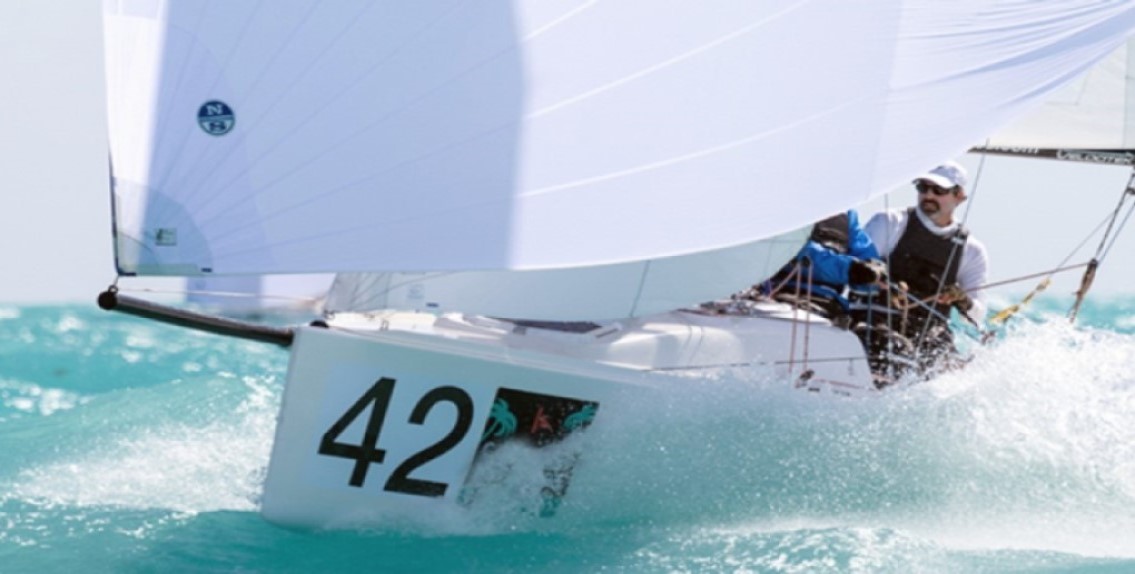NORTH SAILS
By: Tim Healy: November 3, 2022
Who sails a J70?
Our competitors in this class range from what we might call “classic” J/Boat club or Corinthian teams to fully professional teams like us. The boat appeals to these different groups because it’s fun to sail—it’s a mixture of dinghy and keelboat—and it’s not technically too difficult. The class also has J/Boats’ backing, and the quality of boatbuilding is high. People are happy to invest, knowing the boats will last.
What’s involved in crewing?
On our boat, we have four crew ranging from 175 to 180 pounds each, for an all-up weight of approximately 710 pounds. There can be three or more people on the boat, there is no weight limit, and a maximum of two people can sit with their legs outboard. Most people sail with four, as the most competitive weight seems to be settling in between 700 and 780 pounds. Some people are experimenting with more weight—above 750 pounds. The risk of having too much weight is too much drag.
What are the three J70 speed tips?
- Prep the bottom and foils carefully in accordance with class rules.
- Adjust mast rake until you have balanced helm.
- Time on the water will make the difference.
What’s the most important performance ingredient?
Owners that do best have consistent dedicated crew at most regattas—whether they are friends or pros. That way they can steadily build on what they learned at the previous event.
What should buyers know when choosing a J70?
J/Boats began building this design in 2012, and buyers choosing a new boat will spend approximately $54,000-$55,000 including sails and trailers. In Europe, where the boats are also built, buyers typically spend €44,000-€45,000. Used boats range from $35,000 to $55,000, depending on condition and equipment.
How do you move a J70 around?
The J70 weighs 1750 pounds (794 kilos), so it’s easy to tow on a trailer. Stepping the mast and rigging up to launch can take an hour or less, once your crew has learned the routine.
The keel is typically hoisted up before the boat is lifted out of the water, although there is a keel-down style of trailer available that makes hoisting the keel unnecessary. When securing the boat for a road trip, we recommend using a set of soft-wood wedges to keep the keel from rattling around and being damaged inside the keel trunk.
How many sails are required?
The J70 class is fundamentally a three-sail class—main, jib and spinnaker (also called a gennaker). At most events, you can only measure and use one of each, although North has developed variations in jib and main designs suited for different wind and wave conditions.
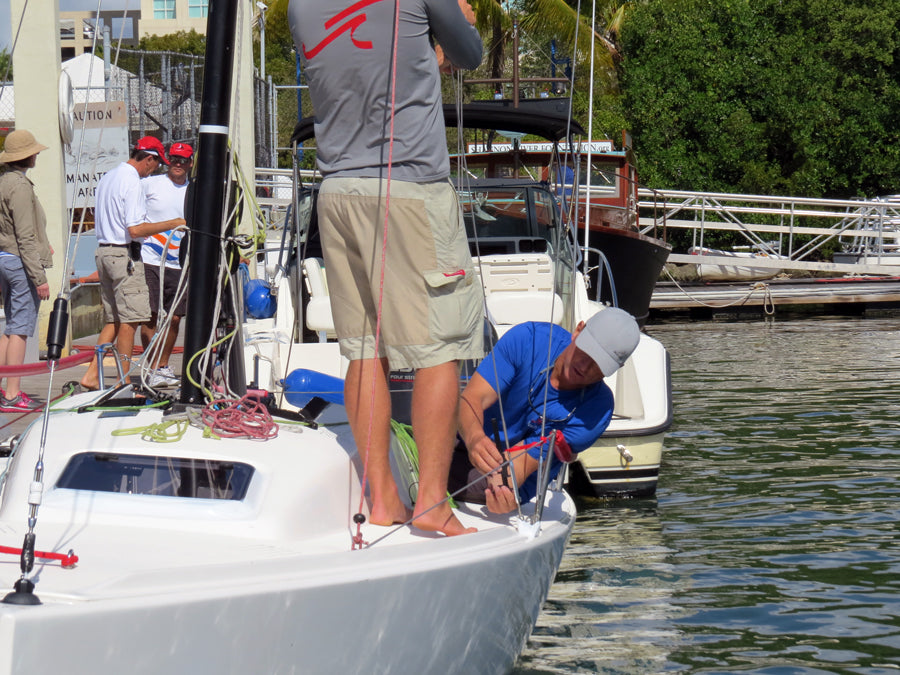
J70 Tuning
What are the keys to rig set-up?
When tuning the J70 for racing, our focus is on headstay length and tension on the upper and lower shrouds. You can read about this in detail in the North Tuning Guide but in broad strokes, here is our method:
In light air, our goal is to generate headstay sag (to power up the jib) and to see about one-half inch of leeward sag in the middle of the mast (to power up the main). This is generally achieved with lighter tension on the shrouds, which makes the mast as flexible and free to bend as possible.
In heavy air, we increase shroud tension until the headstay remains tight when we pull the backstay on. If you make the lowers too tight, you can’t flatten the main enough. You want to just see inversion wrinkles, and the headstay should not be bouncing around more than one inch. Also, the mast tip should fall off to leeward by about one inch.
The headstay length is also a factor, but we only adjust that in a range of .25 inches, and we set it before we leave the dock. Since we started sailing J70s, top competitors have slowly been adding more mast rake, and we’re now sailing with up to an extra inch of headstay length compared to four years ago.
What other control systems are important on the J70?
Most crews mount extra cam cleats for the jib sheets on the windward side so the jib can be led from the leeward cleat to the windward cleat. Out of the tack, the trimmer will trim the jib 90 percent of the way in, cleat the sheet to leeward and also cleat it to windward on the way to hiking out. Once up to speed, either the jib trimmer leans in or the mainsheet trimmer leans forward and “banjos” the sheet to final trim by leaning or stepping on the sheet between the two cleats. On our boat, we prefer to sheet directly to the windward winch, the same way we sheet to windward on a J/24. In that scenario, the helmsman trims the mainsheet and the next person forward controls the jib.
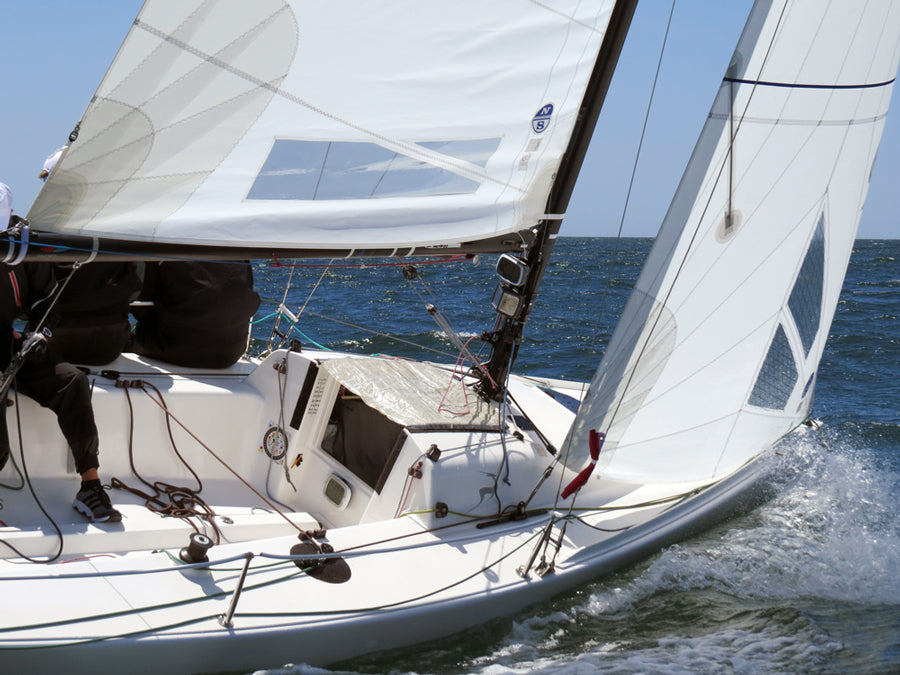
J70 Upwind Sailing
Upwind, where does the J70 crew sit?
In light to moderate winds and a flat to modest wave state, slide crew weight forward! Note that class rules prevent anyone from sitting in front of the mast other than temporarily to make a repair, etc. Both outboard-facing crews should have their weight up against the bulkhead—one might be on the rail and one at the forward end of the cockpit— and the third crew should be tight against them. The skipper will typically sit with his or her hip against the winch. A crew can stand in companionway but is not allowed to put head or shoulders below deck.
Even when it’s windy, J70s like weight forward until it gets choppy and you take water over the bow. Then slide aft, typically with the two legs-out crew pushed against the back stanchion. The crew with legs in moves aft to the winch, straddling it or even sitting behind the winch if it gets rough enough. Before the main trimmer goes that far, the skipper can move aft a foot or more.
How do you trim the J70 mainsail upwind?
The boats have two distinct modes—high and slow or fast and low. As you might expect, you trim the main leech harder for height and leave it more twisted for speed. In speed mode (or when accelerating), all the leech telltales should be flying. In height mode, the two upper leech telltales will stall. Maintaining a constant angle of heel is critical to maximizing performance in each mode, because then the helmsman’s feel for helm load will only be affected by sail trim.
You can use the high and slow mode at times, such as getting off the starting line, but you pay for it if you do it too long. Sailing a little lower and faster nets out over time, because better flow over the foils reduces leeway.
How do you trim the J70 jib upwind?
On the J70, the sheeting angle to the jib lead on the track is too wide for a lot of conditions, so we “inhaul” the jib with the weather sheet. If you’re not familiar with the concept, it basically means after trimming the jib normally, you tension the windward sheet as well, moving the clew of the jib inboard.
The amount that we inhaul the jib—and how high we can point—depends on how easy it is to keep the bow steady; for example, in flat water, we typically inhaul more because we can keep the bow steady and control angle of heel easily. One telltale sign that you need a wider sheeting angle is if you need to steer the bow up and down a fair amount. You can use excessive inhaul if you need to shift into a serious point mode, but you pay for it speed-wise.
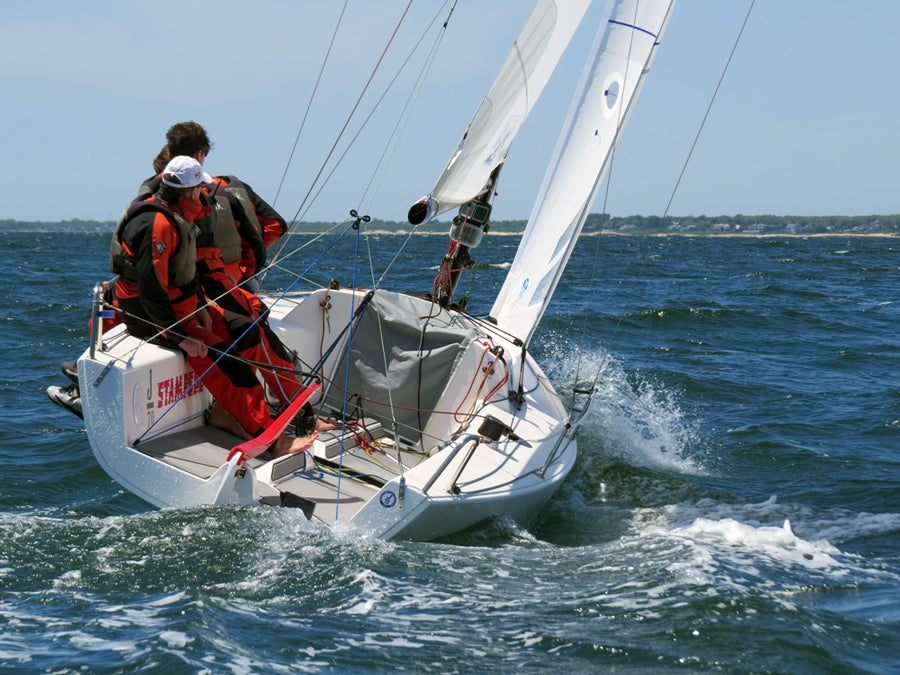
In flat water we sail with a fairly flat foot and sheet harder with a tighter leech profile; in choppy conditions, we keep the foot deeper and the leech twistier. Due to the angle of the sheet, the inhauler has the effect of moving the jib lead forward, so the more inhaul you use, the farther you need to move the lead back.
The jib-lead holes in the track are typically 1 to 1.5 inches apart, and in heavy air without inhauling we normally have 4 to 5 holes showing in front of the car. If we’re inhauling significantly, the lead can go aft until 8 holes are showing. We try to be a little conservative in how far we go in case conditions change and we suddenly have to blow off inhauler, leaving our lead way too far aft.
What does a good team look at when sailing upwind?
On our boat, the helmsman trims the main upwind and the jib trimmer is the other crewmember sitting with legs in. If a bad set of waves are coming and we’ll need to accelerate, we ease the leeward jib sheet; if we realize we’ll be sailing into choppier water for several minutes, we may adjust both the inhauler and the jib sheet. If it’s a long-term change in conditions, we’ll talk about changing the jib-lead position before our next tack.
If all we did was ease the leeward sheet, we have good marks on both sheets so both helmsman and trimmer can see where we are in the range. If we need to make a bigger adjustment, the trimmer will move to leeward long enough to check that the jib telltales aren’t stalled.
The whole time, I’m asking our tactician on the rail about boatspeed. “How is this mode?” When I ask, they assume I changed something and the response might be, “Good. We’re netting out fast forward” or “we’re netting out with great height.” If they say, “We’re netting out even, a bit higher but slower,” that’s OK, but then I’m searching for our next speed move.
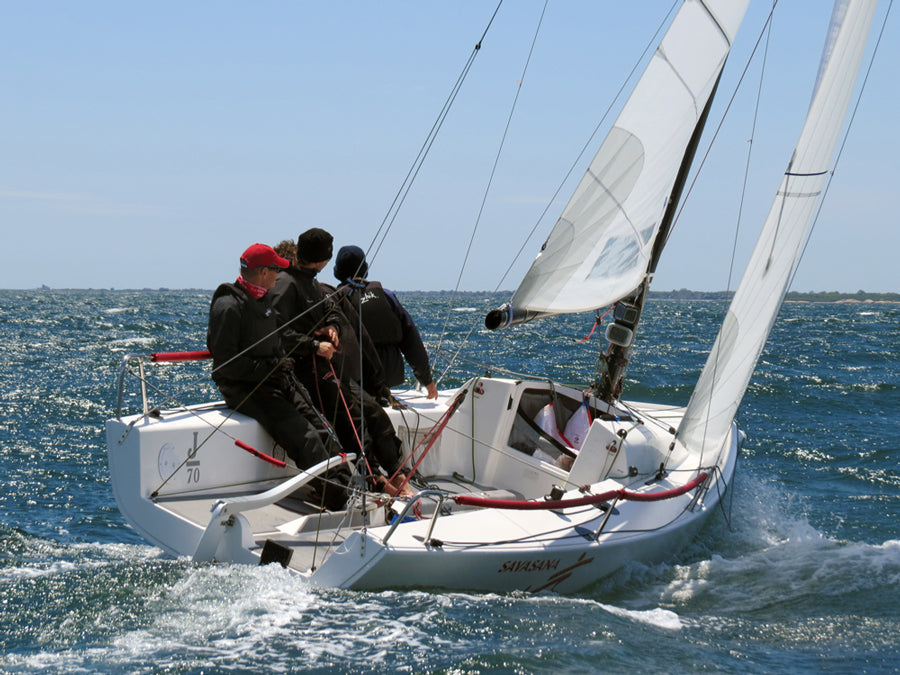
Who calls tactics upwind?
On our boat, except inside three boat lengths to the mark, one of the two crew with legs out does the tactics upwind. When they say, “Tack,” we tack. When you sail with good people you trust, hesitating even a second can make the difference in the call. When they completely own it, they can expand on their own responsibility and see the whole picture, which is ultimately what you want.
J70 Downwind Sailing
Where does your J70 crew sit downwind?
In most conditions downwind, the J70 likes weight forward with the crew all up close to the cabinhouse. In 8 to 10 knots, our bow person is in the companionway or crouched on deck up forward. Our tactician is all the way forward on the leeward tank where they can see under the kite to call laylines. Under 8 knots, the bow person moves to leeward with the tactician.
The spinnaker trimmer is all the way forward on the weather side, up against the bulkhead. The tactician and the bow control heel with little movements, making gross adjustments if needed. As helm I sit on the weather tank with my forward hip up against the winch, straddling the traveler.
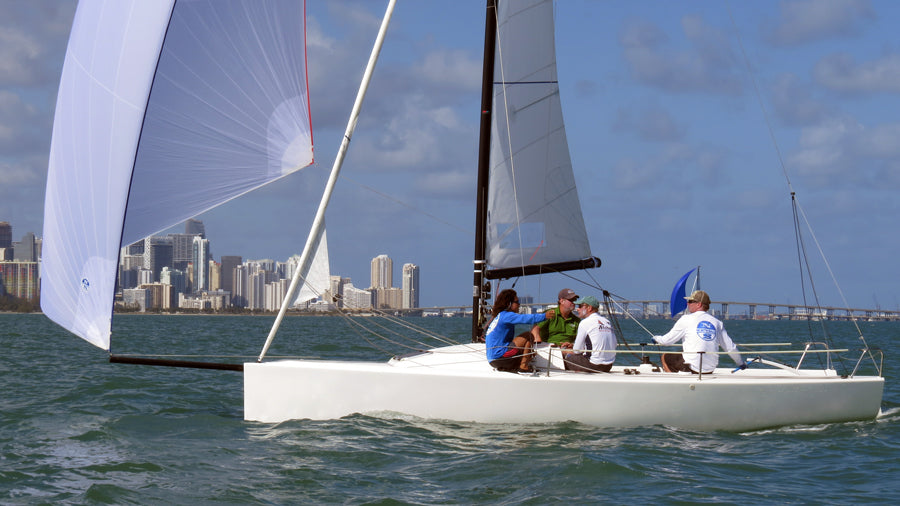
When the breeze picks up to 12 or 13-knots, the J70 starts surfing. The crew needs to stay forward to get on the wave and then move weight back enough to avoid crashing into the next wave. At 14 or 15 knots of breeze, you’ll get on waves with the bow up and start planing. We try to stay high initially to keep planing, surfing down a wave once the apparent wind goes forward. This is what we call “lazy planing,” where we’re still aggressively playing our weight forward and back to catch waves.
In 17 to 18 knots of breeze, we aggressively shift our weight back and really begin planing. I move closer to the aft stanchions, the spinnaker trimmer moves behind the winch, and the tactician might even move behind the winch, too. The next move, at about 20 knots, is to get the tactician behind the helmsman, standing or sitting, and the bow behind the winch. Now the boat is flying!
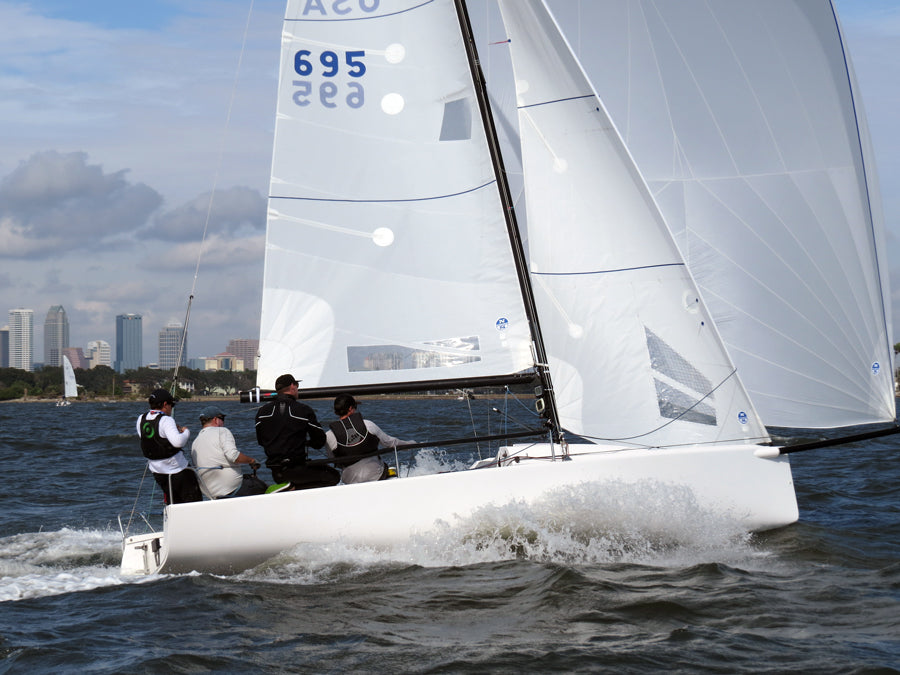
What are the keys to lighter-wind trim when flying the chute?
In up to 7 knots of wind, we sail in VMG (“velocity made good”) mode, which means sailing higher jibing angles to maximize our velocity toward the next mark. Practically speaking, we heel the boat slightly to leeward and sail high enough to keep the chute filled. In this mode, our jib is rolled up and our tactician is giving give steady feedback on whether a higher or lower angle would be faster.
In 8 to 13 knots we sail as low as possible, keeping speed up, and easing the kite and rotating the luff around to weather. As a general rule we sail the boat flat, but there are times when we rock the boat a few degrees to weather. Unless it’s super choppy, we’ll ease the tackline up 4-5 inches, which allows the luff to rotate to weather so we can sail slightly deeper.
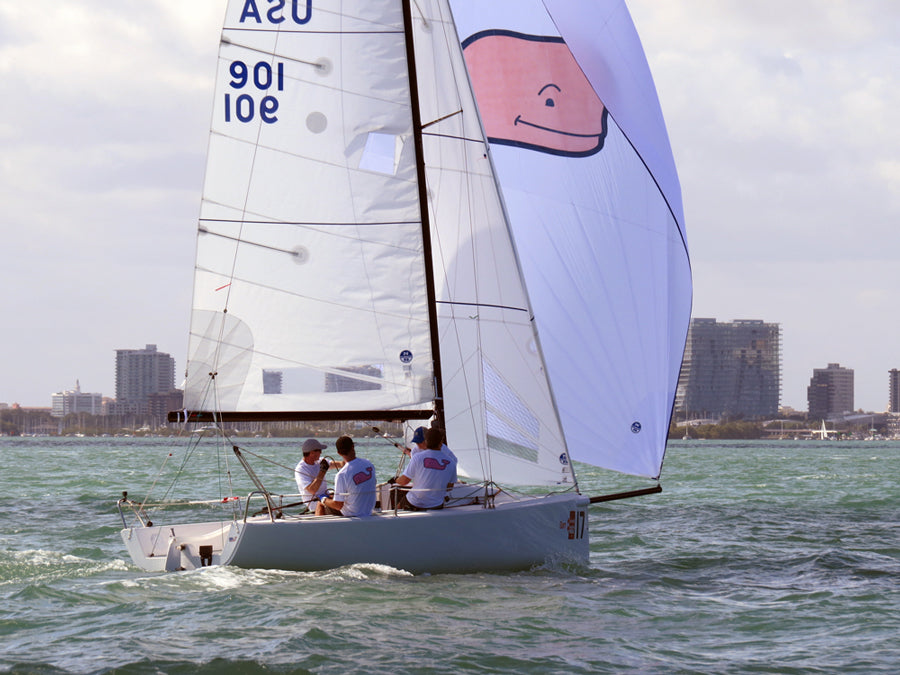
The helm and spinnaker trimmer need to get in sync with a conversation like, “How’s that feel there?” “Feels soft; come up a bit.” Meanwhile, the tactician provides feedback on the general mode we’re sailing compared to the fleet.
The J70 spreaders are swept and there are full battens in the upper part of main, so it’s important to set enough vang tension to control the upper leech. We look for a small S turn in the battens around the shrouds, keeping the leech a little firm but not too tight. We add more vang as the breeze comes up and ease in lighter air.
What are your downwind trim tips when the J70 is planing?
As soon as you are planing, unfurl the jib. The apparent wind comes far enough forward that the added sail area helps. Be sure the jib is never over-trimmed; the upper leech should open so it doesn’t restrict flow to the kite. Once set, the jib requires little active trimming.
In 20 knots, ride the edge! You want the most power you can get without losing helm control. The controls to depower quickly are vang, mainsheet and spinnaker. All three can be eased at the same time to depower and then trimmed back in as soon as the boat is back under control. If you’re in the zone, the spinnaker trimmer doesn’t have to trim in and out a lot. Use the main as a trim tab, a smaller adjustment, and sail the boat as high and fast and as powered up as you can. The goal is to avoid loading up the helm to the point that the rudder cavitates and the boat spins out. The windier it is, the less vang you should use and the twistier the main should be. On our boat, the tactician is usually playing the mainsheet and I’m saying, “Ease, trim, ease, trim,” and sometimes “Big ease!” When we are in sync we can push it harder and sail closer to the edge. The closer to the edge, the faster we go.
If you do wipe out, blow the vang and quickly let the spinnaker halyard down about 8 feet. That should get the boat back upright so you can bear off, pull the halyard back up, and go for it again!
In 17 to 18 knots, you might be more active on the spinnaker sheet as you try to surf low on waves. There are bigger apparent wind changes, and pumping the spinnaker is often effective at getting the boat over the next wave. Kinetics rules allow for one pump per wave on the mainsail, but there’s no restriction on pumping the spinnaker as long as you achieve a surf. That being said, pumping the main is very effective in this wind strength, especially if you can get in sync with a big spinnaker pump.
In 14 to 16 knots, we are much more aggressive on trim due to the big shifts in apparent wind strength and direction. On a good surf the apparent wind goes forward until we crash into the next wave, when the apparent goes way aft. At that point, we stay fast by easing both spinnaker and main, heading up, and then trimming again. If we find ourselves in displacement mode for too long at the bottom of a wave, we furl the jib and wait for the next planing puff.
When do you switch between displacement and surfing modes?
In 12 to 14 knots, if there are long stretches, say 30 seconds, between having enough wind to catch waves, you’re better off furling the jib and sailing low. If you’re not sure, it’s safer to stay in displacement mode. But keep asking your tactician if you should shift modes to match other boats.
If you’re sailing in a breeze with well-defined puffs coming off the shore, we roll the jib out, turn up 10 to 15 degrees to meet the next puff, and get on a plane. When the puff goes away, we furl the jib and turn down. We see big gains and losses in these conditions.
How do you handle the J70 backstay when downwind sailing?
When it’s ripping, you don’t have to ease the backstay. Keep it hammered on. The main doesn’t need more power, and by pulling the mast back you’re keeping the luff of the spinnaker tight. (For the same reason, keep the tack line all the way down when it’s windy.) Our backstay will be eased in 15 knots, although not completely slack. In a VMG or reaching mode in light air, the backstay should be completely slack.
When do you sail a J70 “wing and wing”?
In 10 knots, you can start to wing the spinnaker on the opposite side from the mainsail. It’s important to pick a place to do it with little traffic astern, to avoid sailing in disturbed air.

To start a wing, sail low, ease the spinnaker, then commit and pull the boom over, making sure there’s some vang on so the top batten pops correctly. Heel the boat to weather after the jibe, and either helm or tactician holds the sheet out as if winging a jib on a small boat. On our boat, I hold the sheet out it because otherwise the tactician has to slide aft.
For us, this has become an effective tactical move to avoid traffic in 9 to 13 knots. Sometimes on the first run when there are lots of boats together, all sailing too high to keep their air clear, we jibe away from the group and head down the middle. But we always check to see whether we are netting out; if not, we shift back to conventional trim.
J70 Boathandling
What are the keys to starting well in a J70?
- Confirm all settings ahead of time by tuning with a partner, as well as knowing your compass headings. Set up the cunningham, backstay, traveler, vang, and jib sheets to your marks so when you sheet in to start, you can get to those marks faster than the boats around you. As a result, you can punch out ahead—that’s the biggest key. This makes a big difference on the J70 because of its weight sensitivity.
- Practice initial acceleration as a team and understand the movement of the bow so you can get to your fastest settings as soon as possible. Know when to flatten the boat—just as you get up to course, but not too soon. Everyone needs to feel when to pressure the rail. Either the helmsman or tactician can make that call.
- The class has allowed use of the Velocitek Prostart GPS-based system for knowing the distance to the line. Practice pinging each end of the line accurately, the same way every time at the boat and the pin. Understand how to read it, which includes learning to think in meters (not boat lengths), and know how fast the meters count down.
- Whatever your prestart routine is, stick with it and don’t get distracted by little things.
Any tips for downspeed sailing in a J70?
We furl the jib for the pre-start when the wind is over 8 knots and, until there’s less than a minute to go, we only pull it out if we need to get somewhere quickly. The boat is quite maneuverable in 8 knots of wind or more, our vision is much better, and we can accelerate into another area, or stay slow, to start wherever there are fewer boats. In light air, keep the jib out before the start to keep the power up and flow over the foils.
How do you make a fast spinnaker set?
Everyone needs to know their job and have the boat ready: the tack line is preset, the spinnaker halyard free of its keeper, and the spinnaker head and corners are out of the companionway. At the mark, we hoist the halyard up at least halfway, then pull the pole out. It’s important to understand the right angle to set at so you’re not too low and burning speed, but also not too high and can’t fill the chute. We put a telltale on the shroud and make sure the wind is at least abeam or just aft of the beam before we set.
When it’s breezy, don’t set if the boat is heeled over; turn down far enough so you have a flat, stable platform. We also ease the vang on the offset leg to reduce the risk of wiping out.
What are the keys to a good J70 spinnaker takedown?
Be sure to plan ahead. In light to moderate winds, you have time to make last-second changes, but not if the boat is planing. In that case, the tactician has to spell out what’s going to happen well ahead of time.
Always take chute down on port side in front of the shrouds, and leave room to turn downwind briefly to unload the spinnaker during the drop. When in doubt, do it sooner. It’s way better in heavy air to take down too early than too late.
On a windward drop, coordinate the turn-down with releasing the leeward sheet, overhauling the weather sheet, and getting the clew around the headstay; once you see the clew, that’s a signal you can release the tackline and pole, which will collapse the chute. While the spinnaker trimmer eases the halyard, the bowman stuffs the chute below.
On a leeward drop, the trimmer oversheets the spinnaker so the foot comes in. Then the bowman grabs the sail mid-foot and pulls in from there, while the trimmer releases the sheet and releases the tackline and pole.
The biggest takedown mistake is letting the tack fall in the water; that’s when you “shrimp”. If you’re late on your takedown and the chute is still being stuffed, be sure to pull the foot in first to get the tack into the boat.
What are the keys to tacking a J70 well?
Over-turning a J70 in a tack is bad, but it’s worse if you don’t turn far enough. In light to moderate air, coming out too high will kill your boatspeed and it can take minutes to get it back. Consistent turns will help the crew sync up the jib trim and the timing of the roll tack—when to make the initial roll, and then when to flatten the boat to accelerate out of the tack.
What are the keys to jibing a J70 well?
When the boat is not planing, the spinnaker trimmer handles both sheets. As the turn begins, ease the leeward sheet until the clew gets forward and closer to headstay. Then turn the boat, allowing enough time for the sheet ease. The trimmer then releases the old sheet and rapidly trims the new one. The bowman helps the new sheet around the headstay and also pulls it down, which helps to fill the spinnaker. As soon as the sail pops full the bowman releases the sheet, and usually the trimmer does a big ease at the same time. Jibe the mainsail after the spinnaker clew passes the headstay.
The most common mistakes we see are coming out of the turn too low, or poor coordination between the ease on the old sheet and the rate of the turn. Also if the boat is turned too fast the kite will go inside the foretriangle, which takes a while to sort out.
Besides handling the sails, everyone focuses on flattening the boat out of the roll jibe. On our boat, the tactician calls the cadence— in 8 knots it might be “2, 1, flatten” but in 12 knots, there’s no delay to scramble across and flatten the boat.
When jibing while surfing or on a plane, choose a good wave to carry the momentum of the boat through the jibe. The spinnaker trimmer’s goal is to fill the sail on the new jibe at a relatively low angle while the crew hits the rail, so the helmsman can then turn up and find a fast planing angle.
What are the most common J70 boathandling mistakes that are easy to avoid?
- Turning too far or too little through a tack
- Poor acceleration off the starting line
- Poor spinnaker management at mark roundings
What boathandling drills do you recommend?
Practice tacking, even by yourself. There’s no need to make it stressful. Take enough time to talk about making the next one better. Put in the repetition so the whole crew can understand what a good tack is, then practice that. The same goes for jibes, sets and takedowns. Keep the stress low and practice doing it well. Always end on a good maneuver.
What’s the coolest thing about the J70 class?
It’s become the most popular one-design keelboat in the world. It’s attracting the best competition and as a relatively new boat, the learning curve is still steep. It’s exciting to be part of that.
Learn more about the J/70 by clicking here.

